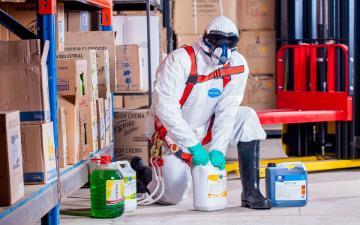
David DeCosse is the director of Religious and Catholic Ethics and Campus Ethics Programs at the Markkula Center for Applied Ethics. Views are his own.
When should a business re-open in the time of the Covid-19 pandemic? This question can’t be answered without addressing issues of risk and safety. Engineering ethics can help think through these issues.
Many businesses produce goods or services that involve significant matters of risk and safety (think, for instance, of a chemical manufacturer). But many other businesses, while concerned about risk and safety, produce goods or services not as weighted with such concerns (think, for instance, of a stationery store).
But engineers on projects large and small always have to think about risk and safety. This constant top-shelf concern can provide insight to businesses now facing serious concerns about the risk of Covid-19 infection and the safety of their employees.
Safety is a Matter of Ethical Values
What we call “safe” is finally a matter of our ethical values. Across times and cultures, human life itself has generally been recognized as the pre-eminent value that we wish to protect by encouraging safety. And it’s no less the case now with this pandemic. There may be terrible figures in history like Hitler who manifested contempt for the lives of millions of people. And there may be within one huge country like the United States different cultural ways of valuing life. But, generally speaking, we value safety for the sake of preserving human life. It’s important not to let terrible examples and subtle differences obscure our general agreement nor undermine the commitment to this value.
Safety is a Matter of Cold, Hard Reality
The engineering ethicists Mike Martin and Roland Schinzinger offer a helpful method for thinking through safety and risk when they say that an engineering project is considered safe if the risks of the project are fully known and if those risks are judged acceptable by reasonable persons in light of “settled value principles.” There’s a lot in this statement. Let’s start with the notion of risk, which affects what is considered safe. On one hand, risk is a matter of science. With Covid-19, it’s crucial to know the scientific basis for things like how it is transmitted; who is most at risk of infection; who is at most risk of death; what can be done to reduce the likelihood of infection. These are hard, often painful facts. But a business must know them and make them fully apparent to its workers and customers. Crazy ideas from a bully pulpit have no place here.
Risk is a Matter of Reasonableness
On the other hand, just drumming scientific facts into workers won’t do. We have to stop and think about the best ways to explain these risks; about engaging workers in the process of specifying risk; about levels of education among different workers; about language barriers; and more. We also have to reject crackpot theories found on Twitter that reflect no impartial process of verifying knowledge. There are common facts and common standards of reason. And the more that risks about Covid-19 infection can be explained in reasonable standards accessible to all, the more the apprehension about risk will be reduced.
Risk a Matter of Perception
There’s the reasonable basis of risk. And then there’s our apprehension about risk, whatever reasonable basis it has. So how can businesses deal with apprehension about risk? The fact is we’re less apprehensive about risks that we assume voluntarily and over which we have some sense of control. These aspects of risk reduction point toward the importance of engaging employees and even customers in decision-making around Covid-19; of favoring voluntary action over coercive policy; and of respecting the importance for employees of having some measure of control over their engagement with the risk of returning to work (Do they belong to outside organizations? Have government support? Belong to a union? Have family support?).
Don’t Forget Culture
Finally, Martin and Schinzinger say that something is considered safe if it is judged to be so by people from within the context of “settled value principles.” Here I think they are saying that everyone comes to a judgment of safety from within their cultural experience. This claim makes it imperative to consider, for instance, the disproportionate suffering endured by the African-American community in the Covid-19 pandemic. Surely that experience informs how many African American workers may view the risk of infection and the safety of returning to work. At bottom, the risk and safety of returning to work are not simply technical questions. The only way forward is through what should not be evaded: the values, vulnerabilities, and culture that constitute all human beings – employers and employees alike.